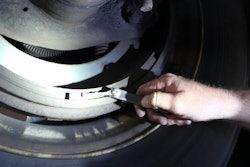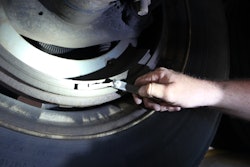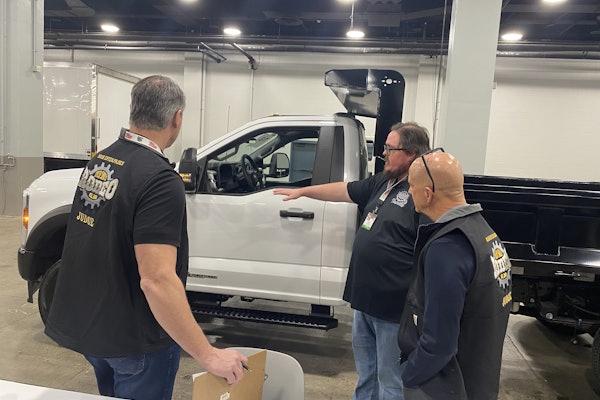By John Smith
 The warning labels that are printed next to an automatic slack adjuster’s (ASA) maintenance guidelines are about as subtle as the Surgeon General’s declarations on a pack of cigarettes. They may not say that brake adjustments will cause cancer, but they certainly leave no question that a readjustment could mask a number of issues with foundation brake components.
The warning labels that are printed next to an automatic slack adjuster’s (ASA) maintenance guidelines are about as subtle as the Surgeon General’s declarations on a pack of cigarettes. They may not say that brake adjustments will cause cancer, but they certainly leave no question that a readjustment could mask a number of issues with foundation brake components.
Despite the maintenance-related considerations that remain – an ASA should not be considered “maintenance-free” – it is difficult to ignore the improvements that have emerged since ASAs became mandatory equipment in the mid-1990s.
“We are enormously better off than we were with manual slack adjusters,” observes Mark Kromer, engineering manager for the specialty products group at Bendix Commercial Vehicle Systems.
His co-worker, service engineer John Hawker, sees proof of the improvements in roadside inspection statistics. A decade ago, out-of-adjustment brakes accounted for 72.3 percent of all out-of-service instances, but the numbers have been dropping at a rate of 4.8 percent a year, he says.
Today’s brakes account for 52.6 percent of out-of-service figures, and that is when you include maintenance issues such as defective ABS warning lamps.
Several design improvements also have emerged in the ASAs themselves.
“The biggest change has been improvement in the durability,” explains Kromer. “It took five to 10 years until all the manufacturers had an understanding of how these things functioned in the field.”
Ball joints and linkages that were once exposed to the elements are now internal to the slack adjuster. Different heat treatments and alloys are being used to strengthen metal components. And seal upgrades have ranged from improved O-rings to the introduction of quad rings and seals in a bid to retain lubricants and block contaminants.
Tightened tolerances are particularly important as transportation departments spread a new formulation of de-icers on U.S. highways.
“The most difficult thing we have to work on now is just the environment,” says Joe Kay, ArvinMeritor Commercial Vehicle System’s engineering manager-foundation brakes, North America. “The road de-icers are highly corrosive, so they are kind of creating a new source of problems.”
Particles of substances like calcium chloride are simply smaller than traditional road salt, and are more prone to finding their way into narrow spaces. Dirt, sand and rust also can block the pawl on the ratcheting mechanism.
But despite the improvements that have been made, today’s ASAs still deserve the attention of maintenance teams.
“As manufacturers improve the product, improve the seals, improve the greases, the immediate tradeoff should not be ‘let’s stop maintaining our product,’” says Kromer.
The considerations begin with the choice of an ASA for a particular axle.
“ArvinMeritor might have a different stroke on the air chamber than a Haldex or Gunite,” explains Kay, referring to the need to use the same style and type of ASA on opposing ends of the axle. If different models are in place, there is the worry about a potential imbalance in the braking system. At the very least, that could affect the life of friction material, but it also could affect the control of a stopping vehicle.
The ASAs also come in different lengths, he adds. A standard linehaul application may have a 5.5-inch lever, but a heavier application could require 6.5- or 7-inch designs, such as those used on a transit bus.
“Get the same slack adjuster body configuration,” he says. “If you don’t get the right body configuration, there may be interference somewhere on the suspension or the axle. You may not even see it until the brake is actuated.”
HEEDING THE WARNING
And, of course, suppliers continue to stress their warnings about adjustments to ASAs, which emerged after the National Transportation Safety Board (NTSB) investigated the crash of a runaway dump truck in Pennsylvania.
“The warnings in existing materials available to owners, drivers, technicians and inspectors of air-braked vehicles equipped with automatic slack adjusters have not been successful in communicating the inherent dangers of manually adjusting automatic slack adjusters to correct out-of-adjustment brakes,” the board said in its 11 recommendations.
It is an important message to repeat.
“You’ve got lining material and shoes and S-cams and the drums themselves. They all have a role in how the slack adjusts,” Kay notes. The hidden causes of excessive stroke can range from broken springs inside an air chamber to worn bushings in the cam shaft. “If you have friction material that swells and grows when it gets hot, the perceived symptom can be the slack adjuster.
“We want the technician to inspect the entire brake and troubleshoot it item by item.”
The regulators agree.
“When an automatic slack adjuster is out of adjustment, it indicates there is a problem with the adjuster, with the adjuster’s installation or with related foundation brake components, which manual adjustment will not fix,” the NTSB stresses in a memo that followed its accident investigation.
“Mechanics had repeatedly manually adjusted the dump truck’s automatic slack adjusters. They did not look for underlying problems with the adjusters or related foundation brake components, so they misdiagnosed the brake problems. They were not properly educated on automatic slack adjusters and how they relate to foundation brake systems.”
The conclusion of the memo was pretty blunt. “The bottom line? Manually adjusting automatic slack adjusters is dangerous. Don’t do it – except during installation or in an emergency to move the vehicle to a repair facility… [it] fails to address the true reason why the brakes are not maintaining adjustment, giving the operator a false sense of security about the effectiveness of the brakes, which are likely to go out of adjustment again soon.”
There is another reason that maintenance teams should abandon the traditional practice of manual de-adjustments, where the slack adjuster is de-adjusted a few times to ensure that the ASA is functioning. The practice can over-ride what is typically a one-way clutch or a mechanism that always is supposed to be engaged.
“You can wear those teeth out,” Kromer says, referring to the damage that could occur. (Bendix believes it has solved the issue by replacing a traditional clutch mechanism with a spring over a pair of shafts.)
THE IMPORTANCE OF GREASE
When it comes to extending the life of an existing slack adjuster, the choice of lubricants is also thought to be vital.
Internal friction continues to be one of the key causes of ASA failures, regardless of the clutch design, Kromer says. This means that a fresh supply of grease should be applied during every recommended service interval, purging any of the old grease that remains.
The choice of grease is just as important as the maintenance procedure itself.
“Almost everybody is using an NLGI-2 grease,” says Adriam Gavrilescu, Bendix global product line manager, slack adjusters. That is why most brands are able to extend lubrication intervals as far as they have. “The same type of grease is now specified in the maintenance [manuals]. This improves the durability and the quality of the slack.”
Standard chassis grease should be left to components such as fifth wheels.
“If you use a good, high-quality grease for your U-joints and driveline, why wouldn’t you use high-quality grease for your slack adjuster?” asks Hawker.
The use of an anti-seize lubricant will help to ensure that the clevis pin on the slack adjuster continues to stroke through its arc without binding, Kay adds.
They are the types of considerations that will ensure ASAs operate as smoothly as possible.
The Science of Slack
Automatic slack adjusters make life for technicians and operators simpler with a largely trouble-free design. However, their operation is quite advanced. Following is an explanation how an automatic slack adjuster operates, according to ArvinMeritor.
Actuation Phase
When the brakes are actuated, the air chamber pushrod moves beyond the predetermined optimum stroke length. The change in geometry between the chamber pushrod and slack lever arm raises the slack adjuster actuator rod.
The piston then contacts the retaining ring, which lifts the actuator. The actuator has spiral serrations on it which jump over the serration on the pawl only if the adjustment is necessary. The components remain in this position until the start of the return stroke.
Adjustment Phase
The returning movement of the air chamber pushrod and slack lever arm on brake release forces the ASA piston, and then the actuator, downward. Contact between the pawl and actuator teeth causes the actuator to rotate.
The rotation of the actuator in its downward travel causes the gear to rotate. The gear rotates the camshaft (cam brake) or powershaft (air disc brake) so that proper brake adjustment is maintained.








